
When it comes to the design and construction of any building, the strength and stability of the structure are crucial factors. This is where beams and load bearing structures come into play. These elements play a crucial role in supporting the weight and transferring the load of a building to the ground, ensuring its stability and safety. In this article, we will delve into the world of beams and load bearing structures, exploring their characteristics, functions, and different types, to provide a comprehensive understanding of these essential components in modern construction. Whether you are a homeowner, engineer, or simply curious about the building process, this article will provide valuable insights into all you need to know about beams and load bearing structures.
Types of beam and load bearing structure

A beam is a structural element that is designed to resist bending and carrying loads. It is one of the most commonly used types of structural members in construction. Beams are classified based on their geometry, support conditions, and load carrying capacity. They play a crucial role in load bearing structures, which are structures that transfer the weight of the building to the foundation. In this article, we will discuss the different types of beams and load bearing structures used in construction.
Types of Beams:
1. Simply Supported Beam: This is the most basic type of beam, where it is supported at both ends by a support or a joint. It is subjected to a vertical load and resists bending. A simple beam can be either a single-span or multi-span depending on the number of supports.
2. Cantilever Beam: In this type of beam, one end is fixed while the other end is free. It is commonly used in structural elements such as balconies, bridges, and canopies. A cantilever beam is designed to resist bending and shear forces.
3. Continuous Beam: This type of beam has more than two supports and is used to span large distances. Continuous beams distribute the load to all the supports, reducing the bending moment at any single point. They are commonly used in bridges and multi-story buildings.
4. Lintel Beam: A lintel beam is a horizontal structural member located above an opening, such as a window or door, to support the weight of the structure above it. It is commonly made of steel, reinforced concrete, or wood.
5. T-beam: A T-beam is a type of reinforced concrete beam that has a flange at the bottom and a stem at the top. It is used when the loads to be supported are heavy on one side. T-beams are commonly used in bridges, multi-story buildings, and other structures.
Types of Load Bearing Structures:
1. Timber Frame Construction: This is a traditional method of construction where the weight of the building is carried by wooden frames. The frame consists of vertical timber columns, horizontal beams, and rigid joints. Timber frame construction is commonly used in low-rise residential buildings.
2. Masonry Construction: In this method, load bearing walls made of brick, stone, or concrete blocks support the weight of the building. The walls not only carry the vertical loads but also resist lateral forces. Masonry construction is commonly used in residential and commercial buildings.
3. Concrete Frame Construction: This method of construction consists of reinforced concrete columns and beams that support the weight of the building. The walls are not load bearing and are used to enclose the building. Concrete frame construction is commonly used in high-rise buildings.
4. Steel Frame Construction: In this method, steel columns and beams are used to support the weight of the building. The walls are non-load bearing and are used for enclosing the building. Steel frame construction is commonly used in high-rise buildings, industrial buildings, and bridges.
5. Composite Frame Construction: This is a combination of steel and concrete where the vertical load is carried by reinforced concrete columns and the horizontal loads are resisted by steel beams. It is commonly used in multi-story buildings, bridges, and other structures.
In conclusion, beams and load bearing structures play a crucial role in the stability and strength of a building. It is important for civil engineers to carefully select the appropriate type of beam and load bearing structure based on the design requirements and site conditions to ensure a safe and
What are Beam types ccording to their shape?

Beams are structural elements that are designed to resist bending and carry loads in a horizontal plane. They are commonly used in the construction of buildings, bridges, and other structures. Beams can have different shapes and sizes depending on their application and load requirements. When it comes to shape, beams are broadly classified into four types – rectangular, square, T-shaped, and I-shaped.
1. Rectangular beams: As the name suggests, rectangular beams have a rectangular cross-section. These beams are the most commonly used and are suitable for small to medium span lengths. Rectangular beams are easy to construct and provide good stability. They are also ideal for supporting heavy loads and are widely used in the construction of residential and commercial buildings.
2. Square beams: Square beams have a square-shaped cross-section, with equal dimensions on all sides. These beams are commonly used in situations where the load is symmetrical and where there is no need for additional reinforcement. They are also often used as support columns in multi-story buildings.
3. T-shaped beams: T-shaped beams have a cross-section that resembles the letter ‘T’. These beams have a wide flange at the top and a narrow stem at the bottom. T-shaped beams are commonly used in the construction of bridges, flyovers, and other structures that require a high strength-to-weight ratio. They are also preferred in situations where there is a need to resist lateral forces, such as wind or earthquakes.
4. I-shaped beams: I-shaped beams, also known as universal beams, have an ‘I’ or ‘H’ shaped cross-section. They are the most efficient and commonly used type of beam. I-shaped beams have a high strength-to-weight ratio, making them suitable for long-span structures such as bridges and high-rise buildings. They are also used in applications where significant deflection needs to be avoided, such as crane girders.
In conclusion, the choice of beam type depends on the specific requirements of a structure. Engineers carefully consider the load, span length, and other factors before selecting the appropriate beam shape. The proper selection and design of beams are crucial for the overall stability and safety of a structure.
Types of beam according to their support system
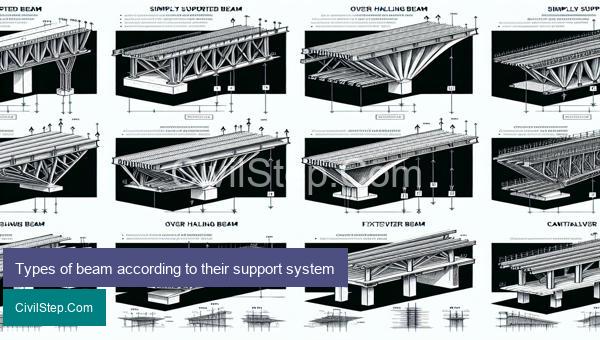
A beam is a structural element that is used to support loads and transfer them to the foundations. Beams are essential components in the construction of buildings, bridges, and other structures. They come in different shapes and sizes depending on the type of load they are designed to support. One of the factors that affect the behavior of a beam is its support system. The support system of a beam refers to the way it is attached to the structure and the type of support it receives from its surroundings. There are various types of beams based on their support system, and they are described below:
1. Simply supported beam
A simply supported beam is the most common type of beam used in construction. It is supported at its two ends by either a wall, column, or beam. The end supports are called the ‘supports’ or ‘rest points’ and the horizontal component is called the ‘reaction’. This type of beam can resist vertical loads, bending, and shear forces.
2. Cantilever beam
A cantilever beam is supported at one end and is free to deflect or rotate at the unsupported end. It is commonly used as a structural element in balconies, bridges, and canopies. This type of beam is designed to carry a load that is applied at its free end.
3. Continuous beam
A continuous beam has multiple supports throughout its length. It is built by connecting multiple simply supported beams. This type of beam is used to span large distances and can carry heavy loads.
4. Fixed beam
A fixed beam is supported at both ends and is highly resistant to rotation. Its supports have zero rotation, and as a result, the beam can resist both vertical and lateral forces. This type of beam is used in structures that require high load-bearing capacity and resistance to deformation.
5. Overhanging beam
An overhanging beam is similar to a cantilever beam, but it has one end that is unsupported and projects beyond its support. This type of beam is commonly used in trusses and bridges to provide extra support and stability.
6. Continuous overhanging beam
A continuous overhanging beam has multiple supports, including one or more overhanging ends. It is a combination of a continuous beam and an overhanging beam. This type of beam can carry heavy loads and is commonly used in long-span structures, such as bridges and roofs.
7. Trussed beam
A trussed beam is a beam that has a series of connected triangular units, called trusses, to provide extra support. This type of beam is commonly used in roof structures and for bridge construction.
8. Beam on elastic foundation
A beam on an elastic foundation is a type of beam supported by an elastic material, such as soil, which provides support and resistance to deformation. This type of beam is used in structures where the underlying ground is soft and can deform under load.
In conclusion, beams come in different forms and shapes based on their support system. It is essential to choose the right type of beam based on the specific needs of a structure. Factors such as the type of load, span, and surrounding environment should be considered when selecting the appropriate beam for a construction project. A qualified engineer should always be consulted for the proper design and installation of a beam system to ensure maximum safety and stability of the structure.
What are T -Beam types ?
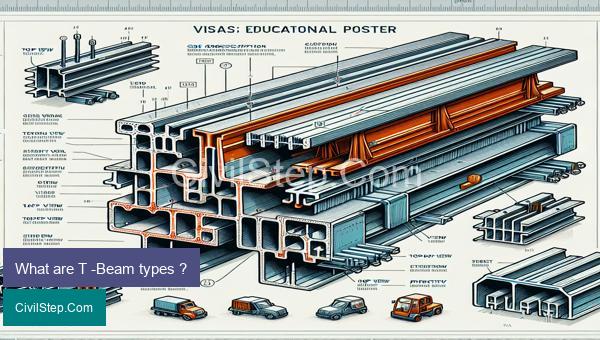
T-Beams, also known as T-End Beams or Tee Beams, are a type of reinforced concrete beam that has a T-shaped cross-section. They are commonly used in construction for structural elements such as beams and columns.
There are three main types of T-Beams: single T-Beam, double T-Beam, and inverted T-Beam.
1. Single T-Beam:
Single T-Beams are the most commonly used type of T-Beams in construction. They have a T-shaped cross-section with a horizontal flange at the top and a vertical stem at the bottom. The horizontal flange provides a wider support area for the slab or wall above, while the vertical stem acts as the web of the beam, providing support against the bending moment.
2. Double T-Beam:
Double T-Beams, also known as parallel T-Beams, consist of two single T-Beams placed side by side and connected by a structural concrete slab or a precast concrete segment. This type of T-Beam is commonly used in constructions where there is a need for large spans, such as in multi-story buildings, bridges, and parking garages.
3. Inverted T-Beam:
Inverted T-Beams are used in situations where the height of the T-Beam is greater than the width. In this type of T-Beam, the horizontal flange is placed at the bottom, and the vertical stem is placed at the top. This design provides a greater support area for the slab or wall above, making it suitable for structures with heavy loads.
T-Beams are commonly used in construction due to their efficiency, cost-effectiveness, and strength. They are also easy to construct, maintain, and transport, making them a popular choice among engineers and contractors.
In conclusion, T-Beams are an essential structural component in construction, providing support and stability to various types of structures. Their various types cater to different construction needs, making them a versatile and reliable choice for engineers in the industry.
What are Angle beam or L -shape beam
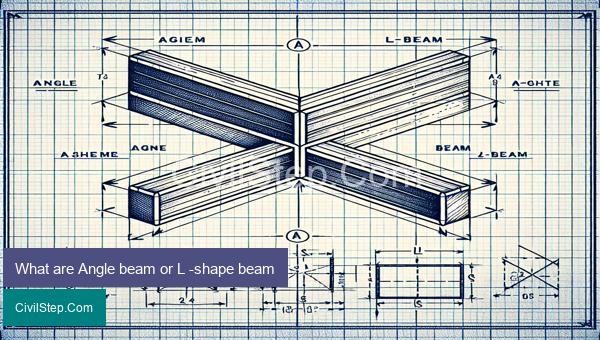
Angle beams, also known as L-shape beams, are structural elements commonly used in civil engineering applications. They are named as such because of their L-shaped cross-section, which consists of two equal-sized legs joined together at a 90-degree angle.
Angle beams are made from various materials such as wood, steel, and concrete, and they can be either hot-rolled or cold-formed. The selection of material depends on factors such as the structural requirements and cost-effectiveness.
These beams are used in different structural configurations, including support beams, floor beams, and roof beams. They are typically used in places where the load is light and the span is relatively short. The L-shape of the beam provides greater stability and strength, making them suitable for use in various structural applications.
One of the main advantages of angle beams is their ability to resist shear and bending forces, which is essential for load-bearing structures. The perpendicular angle between the two legs of the beam allows for efficient distribution of the load, making it a reliable structural element.
Moreover, the L-shape design of the beam allows for easy connection with other structural elements, such as columns and girders. This makes them suitable for use in different types of construction, including buildings, bridges, and industrial structures.
Angle beams are also advantageous in terms of cost and time efficiency. They can be prefabricated in a factory setting and assembled on-site, reducing construction time and labor costs. Additionally, they are lightweight, making them easy to transport and handle during construction.
However, one limitation of angle beams is their vulnerability to torsion, which is a twisting or rotating force. Therefore, they are not recommended for use in high-rise buildings or structures that experience significant wind or earthquake loads.
In conclusion, angle beams or L-shape beams are commonly used in civil engineering for their versatility, strength, and cost-effectiveness. They play a crucial role in providing structural support and stability to various construction projects.
What are simply supported beam
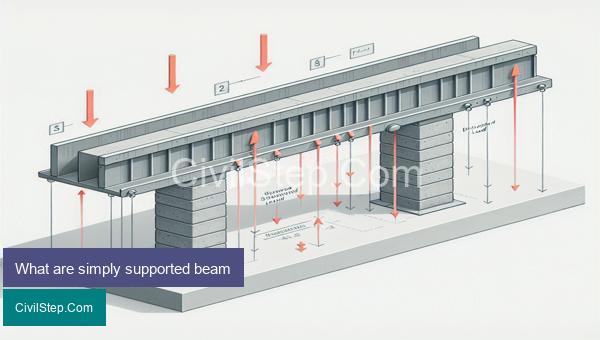
A simply supported beam is one of the most commonly used structural elements in civil engineering. It is used to bear loads and resist bending forces in building and bridge construction. As the name suggests, a simply supported beam is a beam that is supported at its two ends, allowing it to freely rotate and undergo bending in response to applied loads.
The structure of a simply supported beam typically consists of a straight, horizontal member with a fixed cross-section. The beam can be made of various materials such as concrete, steel, wood, or composite materials, depending on the specific requirements of the project. In most cases, the beam is rectangular or square in shape, with a constant depth throughout its length.
The two supports at the ends of the beam can take different forms, depending on the type of load that the beam is designed to carry. The most common type of support used in simply supported beams is the roller support, which allows the beam to rotate freely and transfer vertical loads to the ground. Another type of support is the pin support, which enables the beam to rotate and also prevents it from moving horizontally. The supports are usually made of concrete, steel, or a combination of both, and they are designed to withstand the forces transmitted by the beam.
Simply supported beams are designed to carry loads primarily through bending. When a load is applied to the beam, it causes it to bend, and the material on the top side of the beam is compressed, while the material on the bottom side is stretched. The beam is able to resist these forces through its cross-section, which has different regions that can withstand compressive and tensile stresses. This makes the beam an efficient structural element that can withstand significant loads.
One of the key advantages of using simply supported beams is their simplicity and efficiency in construction. They can be easily manufactured, assembled, and installed, making them ideal for use in a wide range of construction projects. Moreover, the design calculations for simply supported beams are relatively straightforward, which allows for quick and accurate analysis for different loading conditions.
In conclusion, simply supported beams are important structural elements that are widely used in civil engineering. Their straightforward design and efficient load-bearing capabilities make them a popular choice in the construction of buildings, bridges, and other structures. Whether it is a small residential project or a large-scale infrastructure development, simply supported beams play a crucial role in providing structural support and ensuring the safety and stability of the built environment.
What are continuous beam?

A continuous beam is a structural element that is designed to support loads and distribute them evenly along its length. It is commonly used in building construction, bridges, and other structures where large spans are required.
Unlike simple beams, which are supported at both ends and carry a single point load or distributed load, continuous beams are supported at more than two points. This allows them to transfer the load from one support to another, creating a continuous load path. The continuity of the beam reduces the stress concentration at the supports, making it a more efficient and economical structural member.
Continuous beams are typically made of reinforced concrete or steel, depending on the design requirements. They can have various shapes, such as rectangular, T-shaped, L-shaped, or trapezoidal, depending on the structure’s needs.
One of the primary advantages of using continuous beams is their ability to span longer distances without requiring intermediate supports. This feature is particularly useful in large-scale construction projects, where it is not feasible to have support columns in between. It also provides more flexibility in architectural design, as there are no limitations in the arrangement of spaces within the structure.
Furthermore, continuous beams have excellent load-carrying capacity, making them suitable for carrying heavy loads, such as in bridges and industrial structures. This is due to the fact that the beam’s continuity ensures that the load is distributed evenly along its length, preventing any local stress concentration.
The design of continuous beams requires careful analysis and consideration of various factors, such as the load magnitude, span length, support conditions, and the type of material used. The beam’s shape and dimensions must be optimized to achieve the desired strength and stiffness, while keeping it within the budget constraints.
In conclusion, continuous beams are a vital component in modern construction, providing an efficient and reliable solution for spanning large distances and carrying heavy loads. Their versatility and structural efficiency make them a popular choice for engineers and architects in various building and infrastructure projects.
What are Contilever beam?
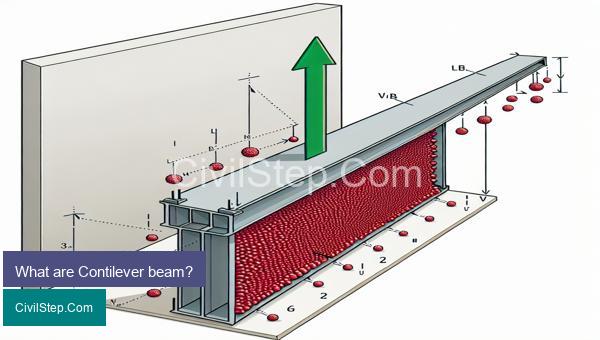
A Contilever beam is a structural element commonly used in civil engineering. It is a type of beam that is anchored at only one end and is free to move at the other end, typically extending horizontally from a support or a wall. This type of beam is widely used in various structures such as bridges, balconies, cantilever roofs, and even diving boards.
The name “contilever” comes from the Latin word “contignere” which means “to hang together”. This accurately describes the characteristics of this beam, as it is suspended and supported by one end while holding the load on the other end.
Contilever beams are designed to withstand bending and deflection under loading conditions. They can support a significant amount of weight over a long distance without the need for additional support in the middle. This makes them a popular choice for creating large open spaces without the interference of structural columns or supports.
One of the main advantages of using a contilever beam is its ability to distribute the load evenly, without creating any imbalance on the foundation. This is because the beam transfers the load through its anchorage to the foundation, allowing the structure to remain stable even under heavy loads.
Furthermore, contilever beams are cost-effective as they require less material than other types of beams, reducing the overall construction cost. They also offer flexibility in design, as they can be curved or angled to create aesthetically pleasing structures.
However, the biggest challenge in designing contilever beams is ensuring their stability and preventing excessive deflection. This can be achieved by carefully considering the beam’s geometry, material properties, and loading conditions during the design process.
In order to increase the strength and stability of contilever beams, reinforcement techniques such as post-tensioning or pre-stressing may be employed. These techniques involve placing high-strength cables or tendons within the beam to counteract the potential for deflection and increase its load-bearing capacity.
In conclusion, contilever beams are a versatile and practical structural element that has been used in numerous iconic structures. With the advancements in construction technology, the use of contilever beams in the field of civil engineering is only expected to grow, allowing for more innovative and efficient design solutions for various structures.
Conclusion
In conclusion, understanding the concepts of beams and load bearing structures is crucial in the field of construction and engineering. Beams play a crucial role in providing support and stability to a structure, while load bearing structures carry the weight of the entire building. It is important to carefully choose the type of beam and load bearing structure according to the specific needs and requirements of a project. With advancements in technology and materials, new and innovative beam and load bearing structures are constantly being developed. By applying the knowledge of these concepts, engineers and architects can create strong and durable structures that can withstand various environmental forces. Overall, a strong understanding of beams and load bearing structures is essential in creating safe and functional structures that meet the demands of modern construction.
